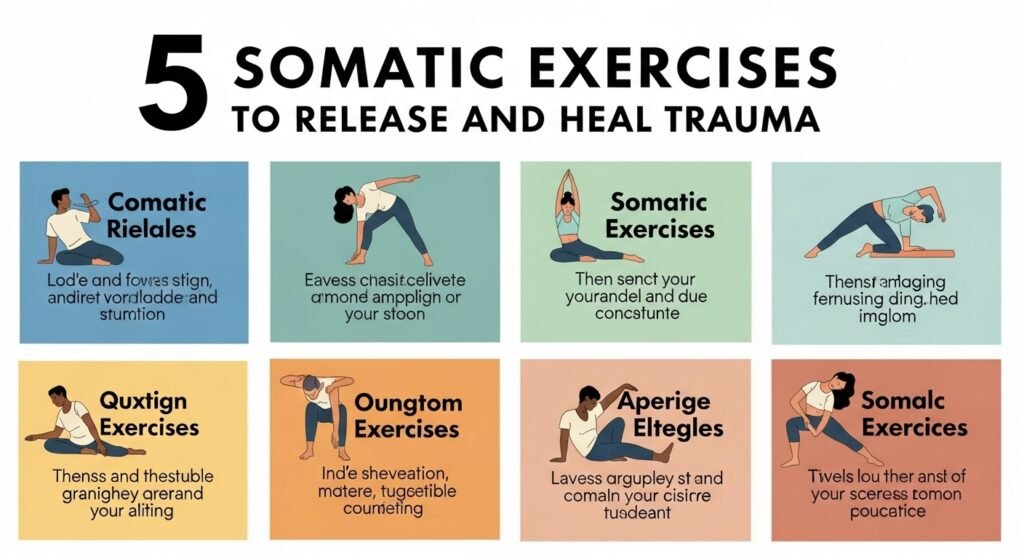
Trauma doesn’t just live in your mind—it often gets stored in your body, showing up as tension, tightness, or chronic stress. Somatic exercises focus on reconnecting with your body through movement, breath, and awareness to gently release this stored trauma and promote healing. These practices are simple, grounding, and can be done at home to help you feel safer, calmer, and more connected to yourself.
Below are five powerful somatic exercises to help you release and heal:
1. Grounding Through the Feet

Grounding is one of the most powerful somatic practices because it reconnects you to the present moment through your body. Stand barefoot if possible, letting your feet press firmly into the floor. Slowly shift your weight between your toes, heels, and sides of your feet, noticing every sensation. Imagine strong roots growing down into the earth, anchoring you and giving you stability. This exercise helps calm racing thoughts, reduce anxiety, and release scattered energy, reminding your body and mind that you are safe right here, right now.
2. Shaking Practice
Shaking is a natural way to release stored stress and trauma from the body—something animals instinctively do after a threat. Stand with your feet hip-width apart and begin to gently shake your arms, then your legs, torso, and finally your whole body. Let the movements be loose, unstructured, and free, almost like you’re shaking water off your skin. Breathe deeply as you shake, allowing your body to let go of tension with every exhale. This practice resets the nervous system, helps discharge trapped emotions, and brings a sense of lightness and freedom. Just a few minutes of shaking can leave you feeling refreshed, calmer, and more energized.
3. Body Scanning with Breath
Body scanning with breath is a gentle somatic exercise that builds awareness and helps release hidden tension. Find a comfortable position—either lying down or sitting—and close your eyes. Begin by taking slow, steady breaths, then mentally scan your body from head to toe. Notice any areas of tightness, heaviness, or discomfort without judgment. As you exhale, imagine sending relaxation to those spots, letting your breath soften and release the tension. This practice not only grounds you but also helps reconnect your mind and body, easing stress and creating a sense of inner calm.
4. Gentle Self-Holding
Sometimes your body needs comfort it didn’t receive during stressful experiences. Wrap your arms gently around yourself, or place one hand on your chest and the other on your belly. Breathe deeply and notice the warmth of your touch. This exercise provides a sense of safety and nurtures self-compassion, helping you regulate emotions.Gentle self-holding is a nurturing somatic practice that provides your body with a sense of safety and comfort. Sit or lie down in a relaxed position, then wrap your arms softly around yourself as if giving a hug, or place one hand on your chest and the other on your belly. Take slow, deep breaths, noticing the warmth and reassurance of your own touch. This simple exercise can calm the nervous system, reduce anxiety, and release feelings of loneliness or fear. It’s especially powerful for healing trauma because it gives your body the soothing signals it may not have received in stressful moments.
5. Pendulation Movement
Pendulation is a powerful somatic technique that helps your nervous system learn balance by moving between tension and relaxation. Begin by bringing your awareness to an area of your body that feels tight, heavy, or uncomfortable. Stay with that sensation for a few breaths, then gently shift your focus to a part of your body that feels neutral, warm, or pleasant. Move back and forth between these two points, breathing deeply as you do. This exercise teaches your body resilience—it learns that even in discomfort, safety and calm still exist. Over time, pendulation can ease trauma responses and create a deeper sense of inner stability.
Final Thoughts
Somatic exercises are gentle yet powerful ways to release trauma stored in the body and reclaim your sense of safety. By practicing grounding, shaking, breathwork, self-holding, and pendulation, you can calm your nervous system and begin to heal from within. Healing is a gradual journey, so be patient with yourself and honor each small step forward.